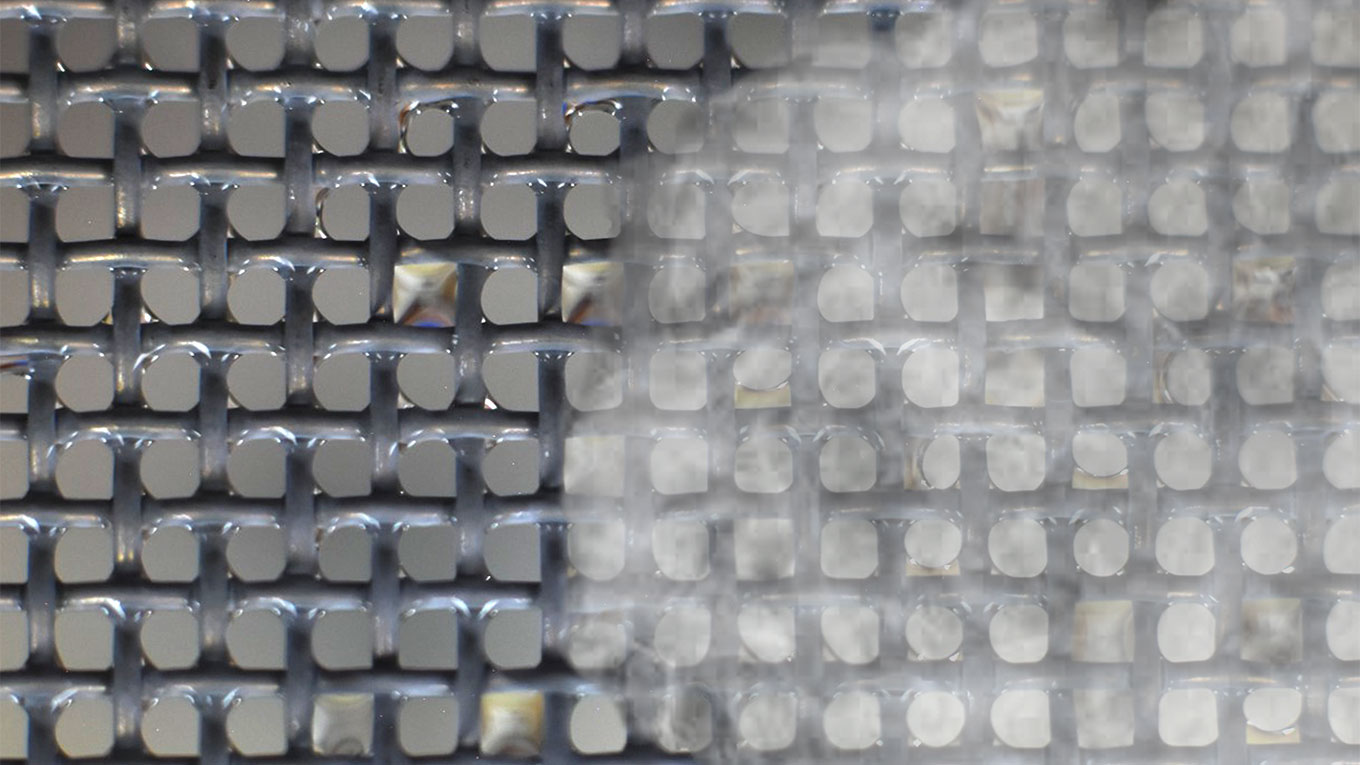Scientists Develop Parallel Method for Fog Harvesting and Water Treatment

Nanoengineered meshes powered by sunlight work continuously to collect water and remove pollutants
Fog harvesting offers regions devoid of lakes and rivers another source for freshwater, but in urban centers, where water is often scarce, there is the added challenge of air pollution. Now, researchers have developed a simple way to simultaneously collect water from fog and remove harmful contaminants, an advancement that could help provide millions of people worldwide with access to safe drinking water.
As reported today in the journal Nature Sustainability, researchers demonstrate how a nanoengineered steel mesh with a special solar-powered coating can collect water droplets from fog, then treat the water to make it safe for drinking. The coating, a polymer consisting of titanium dioxide nanoparticles, has the unique ability to stay reactive once exposed to sunlight and remove pollution, rain or shine, around the clock.
This fully passive, hybrid approach to collecting and treating water is “a first in its field,” according to principal investigator Thomas Schutzius, assistant professor of mechanical engineering at UC Berkeley. Previously, he was an assistant professor at ETH Zurich, where most of this work was completed.
“With water harvesting, we want to solve the problem of creating drinkable water where it’s needed, but there’s the concurrent problem of air pollution in urban centers,” said Schutzius. “We think the answer is parallel treatment, so our goal was to develop fog collectors that could both collect water and remove some of this pollution — especially, organic pollution — while staying passive.”
All-day, all-weather solution
For years, researchers have been developing passive systems to efficiently harvest microscopic water droplets from fog, often using large, vertical fences of nanoscopic woven mesh. This prior work, however, focused on uncontaminated fog. In urban and industrial settings, and even in downwind areas, fog droplets can become contaminated with dangerous levels of organic pollutants, many linked to cancer or other serious health problems, making the collected water unsafe to drink.

To remove these contaminants from the captured fog water droplets, the researchers looked to polymer coatings. Lead author Ritwick Ghosh, a scientist from the Max Planck Institute for Polymer Research and a visiting researcher at ETH Zurich, had previously discovered that it was possible to treat, to a limited degree, contaminated fog by using mesh coatings containing photocatalytically active metal oxide nanoparticles such as titanium dioxide.
Such coatings become reactive when exposed to sunlight and cause pollution molecules in fog droplets to decompose into harmless agents, making the collected water safe to drink. But these coatings required active and continuous ultraviolet lamp illumination to do the job, which impeded their ability to effectively treat against organic pollutants.
In this latest study, Schutzius and Ghosh took the next step to make treatment fully passive: They optimized the nanoparticle coating so that it could continue treating the water without requiring around-the-clock exposure to UV light.
“The key here is that we can make the surface reactive when it’s sunny, and it stays reactive even when it’s foggy or cloudy — exhibiting almost a capacitive-like behavior,” said Schutzius, describing the reactive coating’s ability to store charge, much like a battery, making it possible to effectively treat water regardless of weather conditions and time of day.
Excelling at treatment
As part of this study, the researchers tested two coating types, hydrophilic and hydrophobic. Both performed equally well at water collection, but the hydrophilic version excelled at treatment.
Because the hydrophilic coating attracts water, collected water droplets form a thin film along the mesh, enabling pollutant molecules to travel a short distance before encountering the mesh’s reactive coating, which then causes them to decay. Conversely, the hydrophobic, or water repelling, coating causes water to build up into a thick layer on the mesh, requiring more time for the contaminant particles to reach the reactive surface.
After conducting laboratory tests with common contaminants, such as diesel and bisphenol A, the researchers wanted to gauge the hydrophilic-coated mesh’s performance in a real-world environment. They then tested the mesh on a rooftop, in direct sun, using methyl orange as the contaminant. Their findings showed that the mesh harvested and treated the polluted fog with “good water collection performance (≈8%) and exceptional organic pollutant reduction (> 90%).”
For context, in related experiments with fog harvesters, researchers were able to achieve maximum collection efficiencies of ≈12% to 17%, though this work was done in a lab using uncontaminated fog. And in Ghosh’s earlier experiments with polymer coated meshes that required constant UV exposure, the amount of organic content removed was less than 36%.
According to Schutzius, fog harvesting has already been implemented to scale in arid regions across the world. Implementing a parallel treatment system may prove more challenging because air pollution can differ, both in its chemical composition and concentrations, from place to place. But he is optimistic that this can be addressed through further testing of the polymer coating, easing the way for future adoption of the treatment system.
“You would first need to pick out the mix of pollutants that’s coming with your fog,” said Schutzius. “Once you understand that, I don’t believe anything stands between you and scaling it up.”
Co-authors of the study are Adrien Baut and Giorgio Belleri of the Laboratory for Multiphase Thermofluidics and Surface Nanoengineering, Department of Mechanical and Process Engineering, ETH Zurich; and Michael Kappl and Hans-Jürgen Butt of the Department of Physics at Interfaces, Max Planck Institute for Polymer Research.
